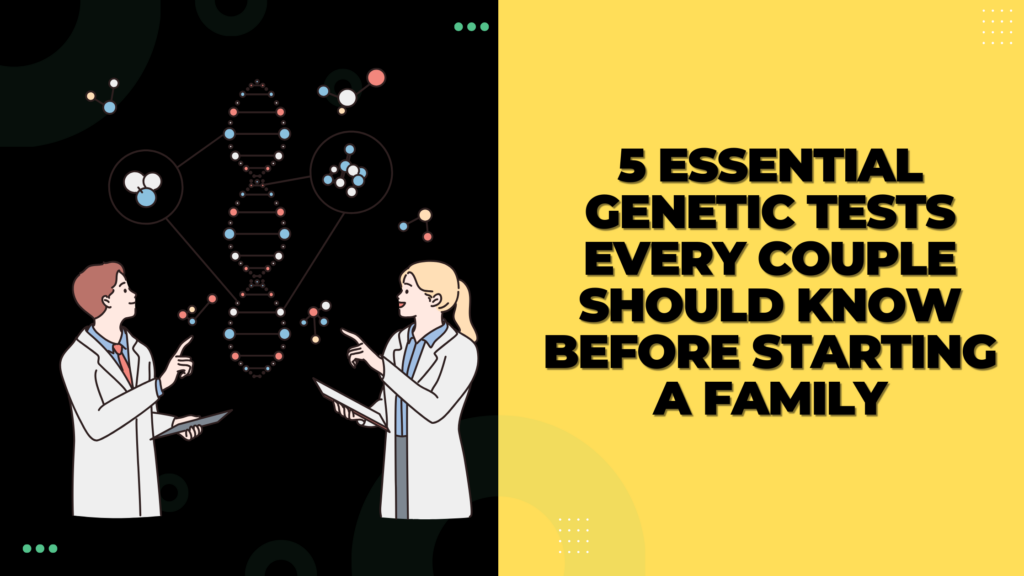If you are planning to start a family, genetic testing can help you to identify possible health risks associated with genes and enable you to make well-informed conditions regarding your child’s future. In this blog we are going to share some most significant and commonly recommended genetic tests for couples
1. Carrier Screening Test
Carrier screening is a most widely used genetic test for couples. Test assesses whether one or both partners possess genes associated with inherited disorders such as cystic fibrosis, sickle cell anemia, Tay-Sachs disease, or thalassemia. If both partners are found to be carriers of the same condition, the likelihood of their child inheriting the disease increases. This screening process is very simple and can typically be conducted using a blood or saliva sample. This kind of genetic testing helps to identify whether an individual carries a gene mutation linked to an autosomal recessive disorder that could be transmitted to their children.
Understanding Autosomal Recessive Disorders
In autosomal recessive inheritance, a child must receive two copies of a mutated gene, one from each parent to develop the disorder. Individuals who have only one copy of the mutation are considered carriers, they usually do not show symptoms but can pass the mutation to their offspring. If both parents are carriers of the same recessive gene mutation, there is a 25% probability with each pregnancy that their child will inherit both mutated genes and have diseases
The Testing Procedure Carrier screening requires a blood or saliva sample, which is examined for particular genetic mutations. Results are typically available within a few weeks. Some tests may target a limited range of conditions, while expanded carrier screening panels can evaluate hundreds of potential genetic disorders. Consequences of Test Outcome A positive carrier result signifies that an individual possesses a mutation for a particular genetic disorder. If both partners are found to be carriers of the same mutation, they may explore various reproductive alternatives: In Vitro Fertilization (IVF) with Preimplantation Genetic Diagnosis (PGD): Testing embryos for the genetic disorder prior to implantation. Utilization of Donor Gametes: Choosing egg or sperm donors who do not carry the mutation. Prenatal Testing: Performing tests during pregnancy to ascertain whether the fetus is affected. It is crucial to seek guidance from a genetic counselor to comprehend the results and consider suitable options.
Emotional and Ethical Considerations Understanding one’s carrier status can evoke a range of emotions, including anxiety, guilt, and stress, particularly upon learning about the presence of a genetic mutation. Additionally, ethical dilemmas may surface, particularly concerning choices related to the continuation of pregnancy or the application of reproductive technologies. Professional genetic counseling plays a crucial role in assisting individuals in navigating these intricate matters.
Advancements: Recent developments in genomic medicine have significantly enhanced the accessibility and scope of carrier screening. For instance, Australia’s healthcare system is incorporating genomic medicine into its clinical practices, thereby offering expanded carrier screening that aims to detect a wider array of genetic conditions.
2. Expanded Carrier Screening (ECS)
In comparison with traditional carrier screening, which typically tests for a limited number of specific conditions, expanded carrier screening evaluates hundreds of genetic disorders simultaneously. This approach is particularly beneficial for uncovering rare or new conditions that may not be linked to a couple’s ethnic background or family history. ECS provides more thorough and valuable insights.
Purpose of ECS The main objective of ECS is to identify individuals who are carriers of genetic mutations that could be transmitted to their children, potentially resulting in serious genetic disorders. By identifying these mutations prior to or during pregnancy, couples can be aware about the condition and plan accordingly by considering in vitro fertilization with preimplantation genetic testing or exploring alternative family planning strategies.
Scope of Conditions Screened The range of conditions assessed by ECS panels can differ widely, encompassing anywhere from several dozen to hundreds of genes. These panels typically encompass genes linked to conditions that, exhibit a carrier frequency of 1 in 100 or higher.
Benefits of ECS Thorough Risk Evaluation: ECS delivers a more comprehensive assessment of potential genetic risks than conventional, ethnicity-specific screening approaches. Fair Screening: By extending testing beyond particular populations, ECS ensures equitable access to carrier screening for all individuals, irrespective of their ethnic origins.
Considerations and Counseling Due to the complex nature and extensive scope of ECS, both pre-test and post-test genetic counseling are essential. Such counseling helps individuals to understand the implications of their test results, the limitations of the screening process, and the potential consequences for family planning. It is very important to interpret ECS findings in light of personal and familial medical histories.
3. Genetic Compatibility Testing
Genetic Compatibility Testing serves as a proactive measure for couples to evaluate the potential risk of transmitting genetic disorders to their children. By pinpointing shared recessive gene mutations, this testing helps in making informed reproductive choices and fosters the well-being of future generations.
Understanding Genetic Compatibility Testing This type of testing aims to identify recessive genetic disorders, which arise when an individual inherits two copies of a mutated gene, one from each parent. While individuals who carry only one copy typically do not exhibit symptoms, the presence of two carriers in a relationship heightens the risk of their children inheriting the disorder. Genetic Compatibility Testing assesses both partners to identify these potential risks. Testing Procedure The process involves collecting blood or saliva samples from both partners. These samples are then examined for specific gene mutations associated with various genetic disorders. The findings reveal whether both partners are carriers of mutations in the same gene, thus evaluating the risk to their future children. Ethical Considerations Genetic Compatibility Testing offers significant insights but also prompts ethical dilemmas, such as issues related to genetic discrimination, privacy concerns, and the risk of stigmatization. It is essential for couples to engage in genetic counseling to fully comprehend the implications of their test results and to make informed choices that reflect their values and personal situations.
4. Preimplantation Genetic Testing (PGT)
For couples undergoing in vitro fertilization (IVF), Preimplantation Genetic Testing (PGT) serves as an effective method to ensure the health of embryos selected for implantation. PGT evaluates embryos for chromosomal abberations, such as those associated with Down syndrome, or specific genetic disorders prior to their transfer to the uterus. This process minimizes the likelihood of miscarriage and enhances the prospects of a successful pregnancy.
Types of PGT: PGT includes various testing categories, each addressing distinct genetic issues:
PGT-A (Preimplantation Genetic Testing for Aneuploidy): This test evaluates embryos for numerical chromosomal abnormalities, such as monosomies or trisomies, which can result in conditions like Down syndrome. By identifying embryos with the correct chromosomal count (euploid embryos), PGT-A aims to enhance implantation success rates and lower the risk of miscarriage.
PGT-M (Preimplantation Genetic Testing for Monogenic Disorders): Previously referred to as preimplantation genetic diagnosis (PGD), PGT-M is designed to identify specific single-gene mutations that cause hereditary diseases, such as cystic fibrosis or sickle cell anemia. This testing is particularly important for couples who are known carriers of these genetic conditions. PGT-SR (Preimplantation Genetic Testing for Structural Rearrangements): This examination detects structural chromosomal irregularities, such as translocations or inversions, which may impact embryo viability and contribute to genetic disorders or pregnancy loss. Procedure The PGT process consists of several essential steps: IVF Treatment: Oocytes are collected from the ovaries and fertilized with sperm in a controlled laboratory environment to produce embryos. Embryo Biopsy: At a designated developmental phase, typically the blastocyst stage (day 5 or 6), a small number of cells are meticulously extracted from each embryo. Genetic Analysis: The cells obtained through biopsy undergo genetic testing to identify chromosomal irregularities or specific genetic mutations. Embryo Selection: Embryos that are determined to be free from the identified genetic concerns are chosen for transfer into the uterus, aiming to achieve a healthy pregnancy. Applications and Benefits PGT is especially advantageous for: Couples with a Genetic Disorder History: Individuals who are carriers or have a familial background of certain genetic conditions can utilize PGT to minimize the risk of transmitting these disorders to their offspring. Recurrent Pregnancy Loss: PGT can assist in identifying embryos with chromosomal abnormalities that may result in miscarriage, thereby enhancing the likelihood of a successful pregnancy. Advanced Maternal Age: As maternal age increases, so does the risk of chromosomal abnormalities. PGT can aid in selecting embryos that are chromosomally normal, thereby improving the chances of a healthy pregnancy.
Ethical Considerations Although PGT presents considerable benefits, it also prompts ethical dilemmas, particularly regarding the selection of embryos based on traits beyond health-related factors. For instance, some companies have started to offer services that screen embryos for potential intelligence quotients (IQ), igniting discussions about the ethical and societal ramifications of such practices.
5. Non-Invasive Prenatal Testing (NIPT)
While Non-Invasive Prenatal Testing (NIPT) is generally performed after the onset of pregnancy, it is important to highlight its precision and non-invasive nature. NIPT examines fetal DNA found in the mother’s blood to identify chromosomal disorders such as trisomy 21 (Down syndrome), trisomy 18, and trisomy 13. This method is safe, highly reliable, and can be conducted as early as the 10th week of gestation. NIPT represents a state-of-the-art screening technique that evaluates small segments of fetal DNA present in a pregnant woman’s bloodstream to determine the likelihood of certain chromosomal abnormalities in the fetus. Unlike traditional invasive methods like amniocentesis, NIPT carries no risk to the fetus, making it a preferable choice for expectant mothers.
Mechanism of NIPT Throughout pregnancy, cell-free fetal DNA (cffDNA) is released from the placenta into the maternal circulation. NIPT requires a blood sample from the mother, usually taken after the 10th week of pregnancy, to analyze this cffDNA. Sophisticated sequencing methods are employed to identify any additional or missing chromosomal material, which may indicate specific genetic disorders.
Conditions Identified by NIPT NIPT primarily screens for prevalent chromosomal abnormalities, including: Trisomy 21 (Down syndrome): This condition is marked by an extra copy of chromosome 21, resulting in developmental delays and intellectual disabilities. Trisomy 18 (Edwards syndrome): This disorder involves an additional chromosome 18, often leading to significant developmental challenges and a heightened risk of miscarriage or early infant mortality. Trisomy 13 (Patau syndrome): This condition arises from an extra chromosome 13 and is associated with severe intellectual disabilities and physical deformities.
Benefits of NIPT Safety: NIPT is a non-invasive procedure, which significantly reduces the risks associated with invasive tests, such as miscarriage or infection. Early Detection: This test can be conducted as early as the 10th week of pregnancy, providing crucial information that aids in timely decision-making. High Accuracy: NIPT has shown remarkable sensitivity and specificity in identifying common trisomies, thereby minimizing the chances of false-positive results.
Considerations and Limitations Screening, Not Diagnostic: Although NIPT is highly reliable, it serves as a screening tool. Positive outcomes should be validated through diagnostic methods such as amniocentesis or chorionic villus sampling (CVS).
Scope of Detection: NIPT is not designed to identify all genetic disorders or birth defects; it primarily targets specific chromosomal abnormalities.



